There are primarily two types of genuine pearls - natural and cultured. Natural pearls are an extremely rare find and are considered a very precious gem. In fact, prior to the development of the process used to create cultured pearls back in the early 1900s, natural pearls were so rare that they were only found in the collections of the noble and the rich, and they were valued more preciously than diamonds.
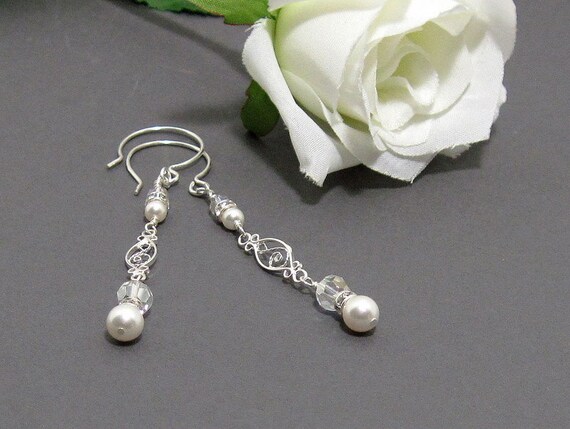 |
| Crystal & Pearl Drop Earrings from Mystic Wynd |
Cultured pearls, on the other hand, can be produced in as little as six months, depending on the depth of nacre desired. The irritation response is forced through the insertion of a foreign matter (typically a tiny piece of shell) into the reproductive organs of the mussel, and allowing the creature to encase it in nacre. This process is called nucleation. With some mussels producing up to 6 layers of nacre a day, the cultured pearl process is decidedly faster, more predictable, and more cost effective than harvesting natural pearls. The finished cultured pearl is no different than a natural pearl from the same creature in quality.
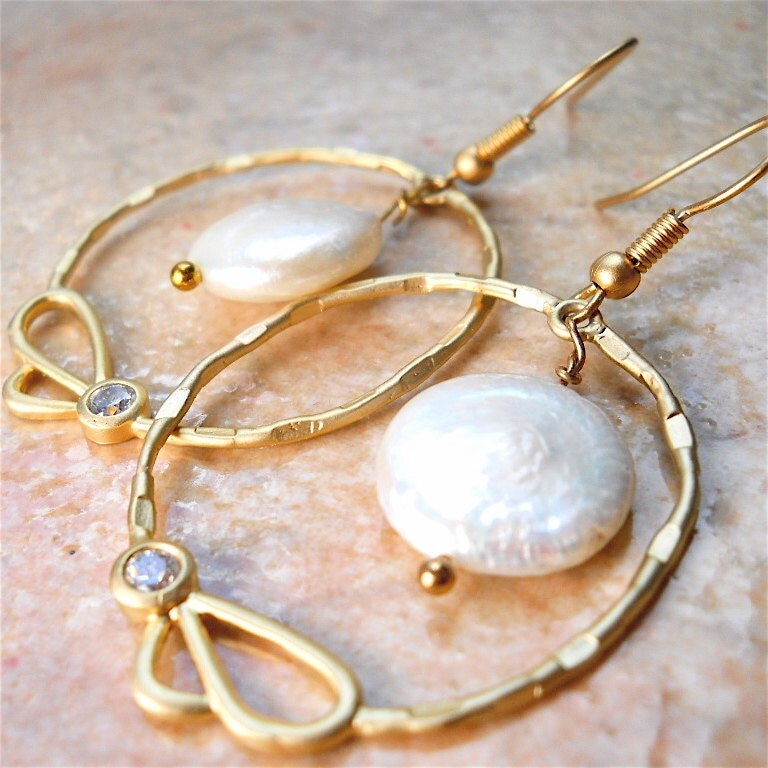 |
| Earthy Bridal Earrings with Pearl Coins from YourDailyJewels |
There are primarily four types of natural and cultured pearls marketed today - South Sea, Tahitian, Akoya, and Freshwater. The first three are all saltwater pearls which come from oysters which produce a single pearl at a time. Freshwater pearls are harvested from mussels, which can produced several pearls at once.
Akoya pearls are the type of pearls that most people picture when they think about pearls. They're typically almost perfectly round (although oval pearls are common in this group as well) , pure white or ivory (although there are also colored varieties), and have the best luster and sheen of the genuine pearls. The Akoya oyster is the smallest of the pearl producing oysters, resulting in smaller pearls overall - usually ranging from about 2-9mm. Most Akoya pearls are cultured in pearl farms along Asian coasts.
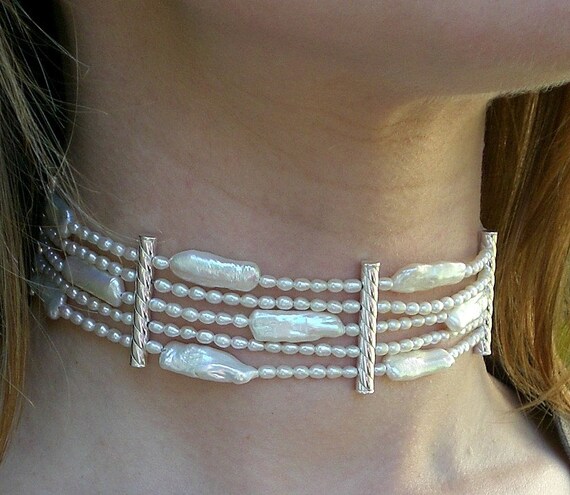 |
| White Stick Biwa Natural Pearls Collar by Zeba |
South Sea Pearls are produced by the golden-lipped (yellow-lipped, silver-lipped) oyster, native to the ocean waters of the Pacific near Australia, Indonesia, and the Philippines. These pearls are the rarest of all genuine pearls, primarily because of their size, which, at 8-20mm, dwarfs the Akoya pearl. South Sea pearls are most often found in shades of white, yellow/gold, and blue. South Sea pearls are more likely to come in a variety of shapes in addition to the more common round or oval.
Tahitian Pearls are the black pearls of pirate legend. Produced by the black lipped oyster found in the waters around French Polynesia and the Cook Islands, these are the only naturally occurring black pearls - although in reality, their coloring tends to range from gray to black with green, blue, or red overtones. The oysters that produce these usually are quite large - up to a foot in diameter and weighing up to ten pounds. Only about 30 percent of the oysters cultured for these pearls actually produce pearls, and the process takes approximately two years.
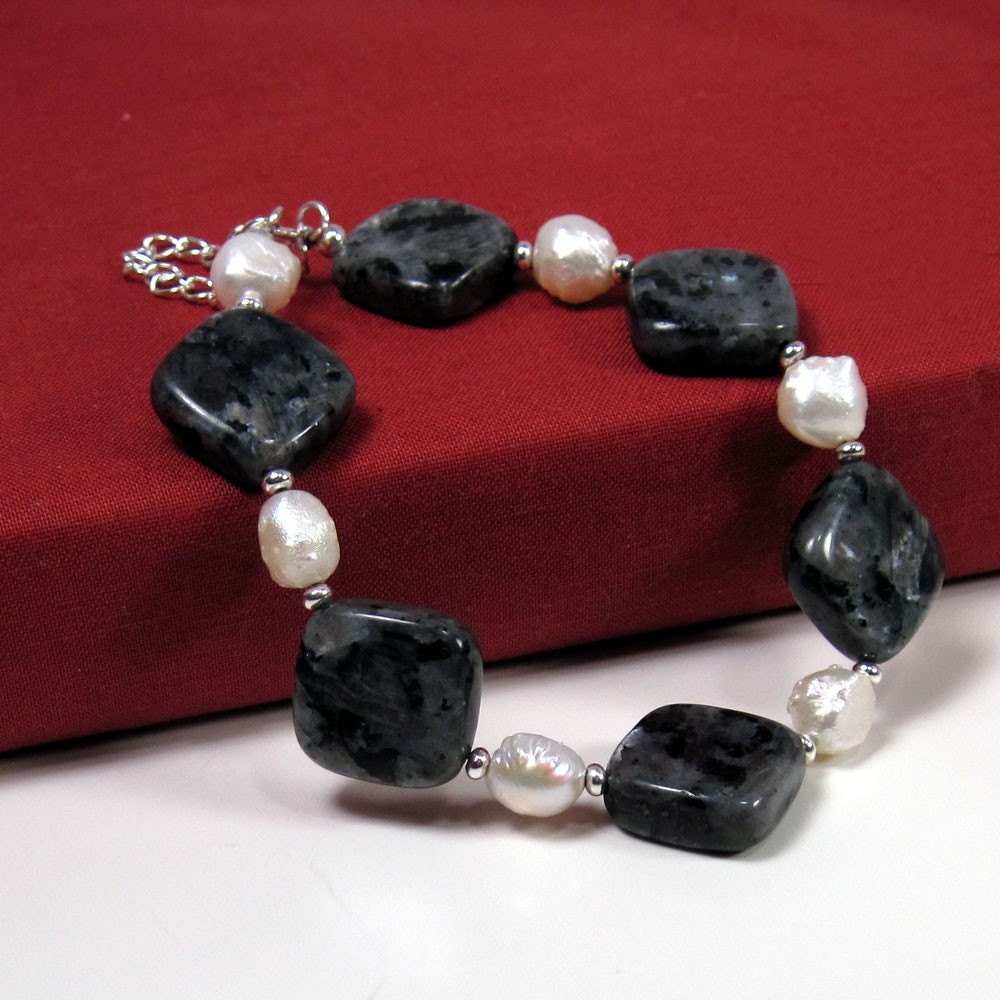 |
| Larvikite and Pearl Bracelet from MysticWynd |
Freshwater pearls are produced by mussels harvested in freshwater lakes, ponds, and rivers. 96% of the pearls harvested in today's market are produced in China, and the pearl farming industry continues to devise methods of creating a variety of colors and shapes through the use of dyes inserted into the oyster during the formation of the pearls or using specifically shaped beads of shell as the irritant to create uniquely shaped pearls. With mussels' ability to create up to 40 pearls over their relatively short lifetime, and in a much shorter time than saltwater oysters, cultured freshwater pearls have changed the pearl industry. Even though fewer cultured freshwater pearls are the much sought-after smooth round pearls, this is a case for quantity over quality since even the more unusual sizes and colors can be used to create stunning and unique jewelry designs.
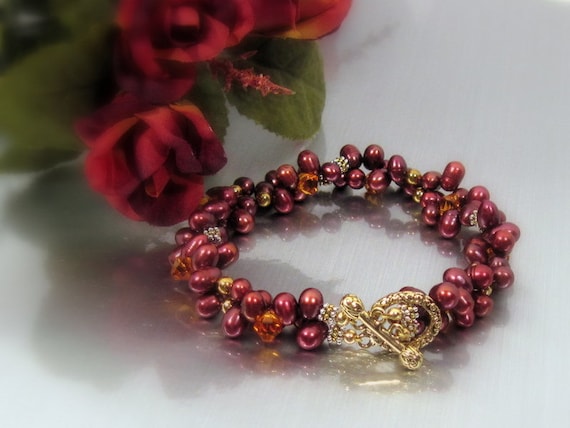 |
| Cultured Pearl & Crystal Bracelet in Pomegranate and Mango by MysticWynd |
Angel Wing Pearl - Freshwater pearl with a flat, irregular triangle shape resembling an angel's wing.
Baroque Pearl - Pearl with a non-symmetrical shape and a noticeably irregular appearance.
Biwa pearl - Cultured freshwater pearl named after the mussel which produces it that lives in Lake Biwa, Japan. Biwa pearls are usually long, narrow, and flat. While they are usually drilled through the flat middle part of the pearl, you can also find Biwa pearls that are top-drilled as well.
Blister Pearl - Pearl caused the by the introduction of an irritant through the outer shell of an oyster. The oyster secretes nacre over the irritant, cementing it to the shell itself, resulting in an irregularly shaped pearl.
Button Pearl - Pearl which has a symmetrical, circular shape and is flattened or slightly flattened on one side with the other side having either a high-dome or low-dome.
Circle Pearl - Saltwater pearl with concave, concentric lines.
Coin Pearl - Pearl having the shape of a small coin, caused by nucleation of a pearl producing mollusk with a small disk shaped irritant.
Drop Pearl - Pearl with a symmetrical, oval or teardrop pearl shape.
Egg Round Pearl - See Oval Pearl or Potato Pearl.
Firecracker Pearl - Smaller top-drilled version of a teardrop pearl. Also known as a wheat pearl.
Irregular Twin Pearl - Pearl created when two nucleations occur side by side and the final result is a single pearl with two nodules, resembling a peanut.
Keshi Pearl - "Accidental" pearl formation which occurs when the mollusk rejects the nucleus (implanted irritant) and grows a 'free form' pearl.
Mabe Pearl - Blister pearl which has been cut away from the shell, filled with a resin, and sealed with mother of pearl to create a flat-back pearl.
Near-round Pearl – Pearl which appears almost round to the eye. Some might be slightly out-of-round, elongated, or flattened.
Oval Pearl - Pearl having a symmetrical, rounded oblong shape. When drilled lengthwise, these are known as rice pearls.
Peanut Pearl - Pearl created when two nucleation occur side by side and the final result is a single pearl with two nodules, resembling a peanut.
Pear Pearl - See Drop Pearl or Teardrop Pearl
Poppy Seed Pearl - See Keshi Pearl
Potato Pearl - Like its namesake, a potato pearl has an irregular oblong shape.
Rice Pearl - Pearl that is small and irregularly shaped (typically a long oval, like a grain of rice) which has a somewhat uneven surface. These pearls are drilled lengthwise.
Rondelle Pearl - Small, thick, coin pearl that is drilled side to side.
Round Pearl - Pearl which appears round to the eye
Seed Pearl - Pearl weighing less than 1/4 grain (1/16 of a carat). Seed pearls are often a secondary pearl, formed at the same time as a larger main pearl.
Semi-baroque Pearl – Pearl with a non-symmetrical, off-round, slightly irregular shape, typically an oval, button, or drop.
Stick Pearl - Cultured freshwater pearl which is almost always long, narrow, flat and drilled through the flat middle part of the pearl. (See Biwa Pearl)
Teardrop Pearl - Drop pearl with a single pointy end, typically drilled side to side, rather than top to bottom.
Wheat pearl - Smaller top-drilled version of a teardrop pearl. Also known as a firecracker pearl.
That's it for today's pearls of wisdom. Have a good one!
xo,


1 comment:
Great post! It took me awhile to hunt down & learn the basics on pearls, so having it here in on succinct post is great! Even learned a few new pearl types (the "firecracker" being the best name, by far).
Post a Comment